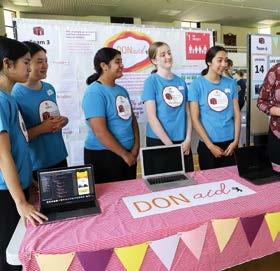
8 minute read
JUNIOR SCHOOL
THIS YEAR WILL BE REMEMBERED AS BEING A VERY DIFFERENT AND INTERESTING ONE. WHILE FOR A TIME WE THOUGHT MANY OF OUR JUNIOR SCHOOL ACTIVITIES MAY NOT GO AHEAD, IT WAS WITH JOY AND GRATITUDE THAT THE GIRLS WERE ABLE TO EXPERIENCE MANY MILESTONE OCCASIONS.
We were so pleased to invite our Year 4 mothers to travel south to Metricup, to participate in the Mother/Daughter camp, albeit a little later in the year than originally planned. The weekend, while wet, was a wonderful opportunity for the mothers to spend time with their daughters, exploring the beautiful property and creating artistic pieces together. It was also with grateful hearts that our Year 5 teachers travelled to Metricup with their classes for the Year 5 Camp. All were excited to come together to learn about Indigenous culture with Wadandi custodian, Josh, from Koomal Dreaming, and about the South-West environment, which was an important focus of the Year 5 program. The Early Years’ girls have been able to continue their Bush School program, discovering the flora of Trigg Reserve, and our Year 4 students worked with actual scientists, which was a valuable experience in learning how important it is to care for the natural environment. Venturing further afield, the girls also explored the Rio Tinto Naturescape in Kings Park, where they further connected with nature and came to appreciate the unique Western Australian environment. It is with gratitude that we have been able to enable our girls to discover and explore this year and participate in interactive experiences that enrich their education. We are equally proud of the Junior School Music Program, from the Kodaly-based classroom programs to the Year 3 strings and the Year 5 band program. The girls have been encouraged to explore and develop their musical skills. An important component of the program is performance. Through the music department’s careful and creative planning, the students and parents have been entertained on many occasions, including being part of the mass choir at Speech Night. I acknowledge all of our budding musicians for their entertaining performances. To have such dedicated and talented teachers at St Mary’s is a privilege for the students. Our teachers inspire and encourage the girls, motivate them and deliver engaging learning experiences. The National History Challenge is one such opportunity. Sabrina and Leigh Van Clef, in Years 5 and 4 respectively, both entered this competition under the guidance of Mrs Dencker Morrison. Sabrina entered the Women’s History Category, based her project on Astronomy at the Perth Observatory and Human Computers, while Leigh’s topic, in the Year 1-4 category, was Servant or Slave in Australia. Both girls were awarded silver medals and we congratulate them on their achievements. As we head towards St Mary’s Centenary year, it is with excitement that we look forward to celebrating and sharing the School’s history with the girls and our extended community.
Helen Adams Head of Junior School
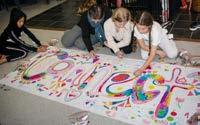
WHERE NATURE INSPIRES LEARNING
CREATIVE SCHOOLS IS A PROGRAM AIMED AT ENHANCING STUDENTS’ ACADEMIC LEARNING AND CREATIVE THINKING SKILLS. INITIATED AND LED BY FORM, A PERTH-BASED, CULTURAL NOT-FOR-PROFIT, IN PARTNERSHIP WITH WA DEPARTMENT OF EDUCATION, WA SCHOOLS WERE ABLE TO APPLY FOR A FUNDING GRANT TO JOIN THE PROGRAM, AND OUR JUNIOR SCHOOL WAS ONE OF ONLY 16 SCHOOLS ACROSS THE STATE CHOSEN TO PARTICIPATE.
The Creative Schools program being well-organised educators, our We explored and wandered the ran for two of our early outdoor learning program thrived. beach environment, learning about learning classes weekly in Terms 3 and 4 and instilled great excitement into our learning. Our visiting practitioner, my Year 1 class was Trudi Bennett and for Mrs Crispin’s Year 2 Class was Daniel Burton. Both are powerful advocates for connecting children with the natural world and worked together with their class teacher and students to guide and encourage us with different approaches to teaching our chosen topic. We embedded the curriculum and content through wonderful connections with nature and looked at ideas through a The students designed and built cubbies from the past, present and future, with emphasis on developing connections with nature and focusing on the Learning Assets implemented in class. This handson approach developed resilience in the girls and allowed them the freedom to learn by instinct. We noticed more children taking risks and working collaboratively as a team. Some students who had difficulty in the classroom with the written component of learning, were able to shine in this environment. sustainability and representing this through ephemeral beach art. The excitement was evident when the children knew it was a Creative Schools afternoon. They were so keen to get out into nature to continue their projects and were so incredibly proud of what they were able to accomplish. During feedback time, they were able to reflect on their learning and relate it back to their Learning Assets. The program has had such a positive impact on the staff and students involved, with the girls different lens. In Term 4, as the weather warmed, we developing resilience, empathy and In Term 3 my class chose the HASS focus of Past, Present and Future to begin our learning journey together. With Trudi’s cubby-building expertise and amazing skill set, and our staff took our learning to the beach. Our HASS curriculum was drawn on to learn about the natural geographical features of a coastal environment and how it changes over time. an understanding of nature, all while having a wonderful play adventure! Deborah Scanlon Year 1 Teacher
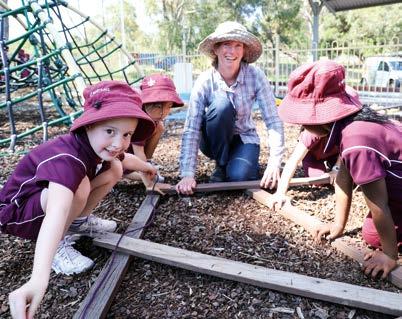
BUSH NESTING BOXES PARTNERSHIP PROGRAM WITH THE FRIENDS OF TRIGG BUSHLAND
OUR YEAR 4 STUDENTS WERE HUGELY EXCITED TO BE A PART OF THIS EXCITING AND IMPORTANT INITIATIVE. FRIENDS OF TRIGG BUSHLAND RESERVE SECURED A LOCAL GOVERNMENT GRANT TO BUILD SEVEN BIRD-NESTING BOXES AND SIX BAT BOXES IN OUR NEIGHBOURING TRIGG RESERVE. WE WERE SO GRATEFUL AND INSPIRED TO HAVE SIMON CHERRIMAN, OF ‘INSIGHT ORNITHOLOGY’ AND JOE TONGA OF ‘NATSYNC ENVIRONMENTAL’ VISIT THE SCHOOL AND SHARE BOTH THEIR EXTENSIVE KNOWLEDGE AND THEIR INCREDIBLE PASSION FOR THE ENVIRONMENT.
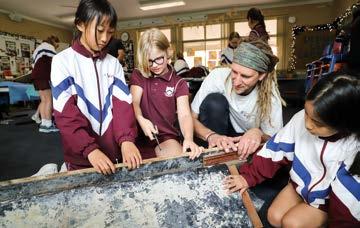
Year 4.2 built and painted the bird boxes with Simon and Year 4.1 worked alongside Joe to build and paint the bat boxes. The girls not only demonstrated excellent woodworking skills, but they also used the opportunity to learn and ask so many interesting and thoughtful questions. Simon chatted to the girls about the different features that the boxes needed to have, such as airflow, nesting materials, wire attached to the inside to allow the birds to climb out (as they can’t expand their wings inside the box), drilling holes in the bottom to prevent flooding and the importance of design in order for the nesting boxes to be successful. The girls were astonished to learn from Joe that micro bats eat up to 1000 mosquitoes every night and bat-nesting boxes are now being used in some orchards and vineyards as a natural way to control pests. They were also fascinated to learn that up to 25 bats could inhabit one box at the same time. Both presenters explained the necessity of nesting boxes due to habitat destruction leading to some of our native species now being endangered. Our girls were so engaged and they enthused about the project. Jaime Kerchavel said that she did not know anything about nest boxes. “But after I built them, I wanted to do more about it because it was so interesting, a lot of fun and it’s good for the environment,” Jaime said.
Sophie Foerster was impressed by the almost total use of recyclable materials used in the construction. “Reusing materials is very important and it is our responsibility to try and do this as much as we can,” she said. Elizabeth Funston said, “We are building these boxes so that the birds like the red-tailed cockatoo, ring-necked parrot and the pardalote could have space to nest. It can take up to 100 years for termites make a tree hollow.” The girls were asked to reflect on the experience and think about how the learning had made a difference to them. Aimee Chong wrote, “This experience made me more aware of the effects of land clearing and climate change. I’ve learned never to waste and that I can help our native animals which I never thought I could.” Ayeesha Vaswani wrote, “The learning we did will make a big difference to me because I know a lot more now.” ‘When Simon and Joe came in, it changed my opinion on both bats and birds. I had no idea that some of our birds were in such danger,” wrote Chloe Devellerez. The girls will wait in anticipation to see the local endangered species attracted back to the School and surrounding bushland. We are so lucky to have Trigg Reserve right at our gates and to be able to play an active role in the conservation and restoration of balance within the bush. This kind of real-life learning with tangible outcomes was hugely engaging in 2020. The girls look forward to continuing the learning about and monitoring of the boxes in 2021. Make sure to look out for them when walking through Trigg Reserve these holidays.
Vikki Kennedy Year 4 Teacher
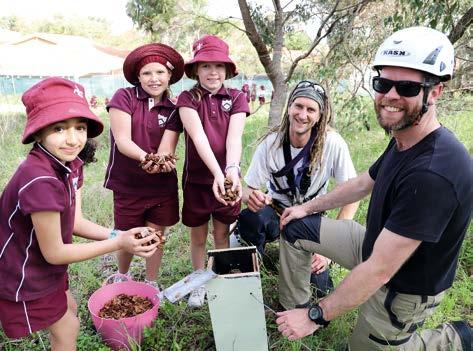
TOP: Simon Cherriman, of iNSiGHT Ornithology, and a volunteer help to prepare the bird boxes with Year 4.2 girls. RIGHT INSERT: Joe Tonga, Natsync Environmental, educates the Year 4.1 girls about the bat boxes they installed in the Trigg Bushland Reserve.




